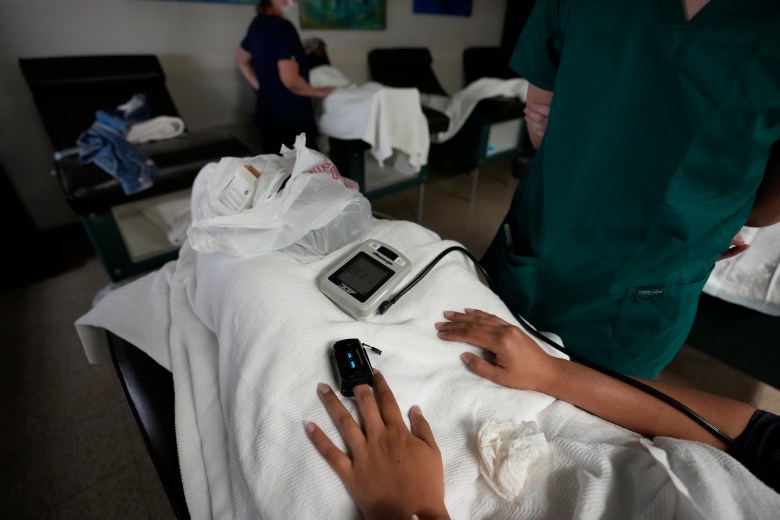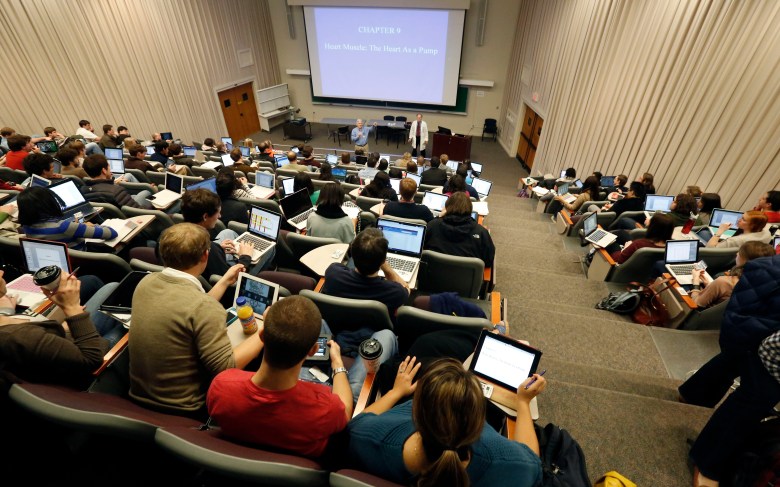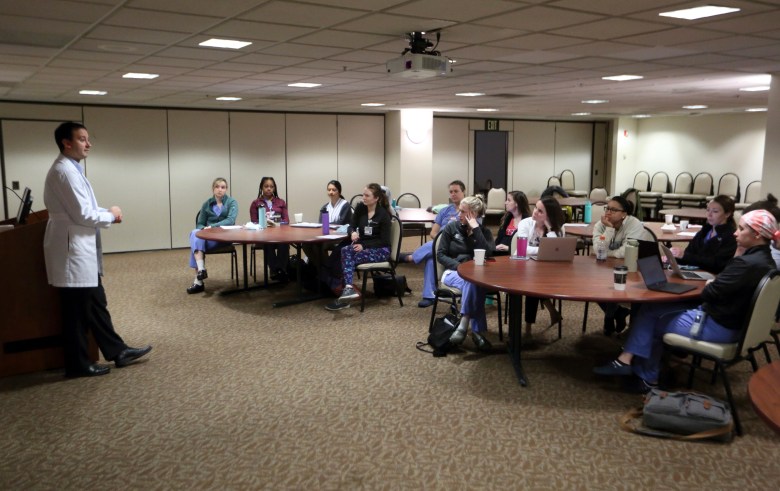When Andrea Soto was 10 years old, her family immigrated to Texas from Mexico. Her grandmother, who lived in Houston, had Alzheimer’s disease, and her parents wanted to be closer to help with her care.

Growing up, Soto often served as an interpreter between her family members and their doctors.
“I did the best I could,” she said, “but there were moments that were complicated, and it went over my head, and we just tried the best we could as a family.”
Today, Soto is a third-year medical student at the University of Texas Rio Grande Valley School of Medicine. She chose to study at UTRGV — located in South Texas, along the border with Mexico — because of the opportunity to work with a Spanish-speaking immigrant population.
“I want to be that brown doctor that a brown little girl who is interpreting for their parents should have had,” she said.
Her goal is to establish a practice that will serve immigrant families like her own, with a specialty in either family medicine or obstetrics and gynecology. But as Soto prepares to apply for her residency after medical school, she’s giving priority to programs outside her home state.
That’s because, despite her desire to stay close to home, she’s concerned she won’t have access to the medical training she needs if she stays in Texas.
“I won’t get the abortion care training I need if I stay, and I’m not willing to sacrifice that,” said Soto.

In states where abortion is now illegal, medical students like Soto are reconsidering their choices, abandoning their original plans in favor of pursuing training in states where abortion is legal.
“It’s a difficult position to be put in,” said Jessica Flores, a second-year medical student at UTRGV, who comes from the small city of Portland in South Texas and has long dreamed of serving her community as a physician. Now that Texas has made abortion a felony punishable by up to life in prison, she is rethinking her plans.
“Do I pursue my education in a state where I want to be ideally, but it’s going to potentially undercut me and not make me as prepared as a physician for my patients? Or do I leave?” said Flores.
In a post-Roe world, thousands of future doctors now face roadblocks to accessing clinical training in abortion care. Experts say these new barriers could ultimately limit access not just to abortion, but to all obstetric and gynecological care.
For years, researchers have warned of a growing OB-GYN shortage, especially in rural communities across the country. Following the Supreme Court’s Dobbs decision, concern is rising that abortion bans will intensify those shortages by making the path to becoming an OB-GYN more difficult and less appealing.
Related: If more students become pregnant post-Roe, are we prepared to support them?
To become a doctor, students attend four years of medical school, then complete a residency in their chosen specialty. OB-GYN residency programs are required to offer access to training in induced abortion, although students with moral or religious objections are permitted to opt out.
This requirement has been enforced by the Accreditation Council for Graduate Medical Education since 1996, and programs unable to meet this standard jeopardize their accreditation status.
But in the aftermath of the Dobbs decision, as state legislators across the country move to enact laws banning or severely restricting abortion, direct access to clinical abortion training has disappeared — or is likely to do so — at the home institutions of thousands of medical residents.
Nearly half the country’s future women’s health care providers could be affected. An April 2022 report in the journal Obstetrics & Gynecology said 45 percent of all OB-GYN residency programs were in states “certain or likely to ban abortion” with the overturn of Roe. Those programs accounted for 2,638 residents out of 6,007 total.
In this new legal landscape, residency programs must balance obeying state laws with staying in compliance with their field’s accreditation standards. In response to the Dobbs decision, the ACGME has drafted revisions to its guidelines that would provide a workaround allowing programs in abortion-restricted states to send their residents out of state for training or, if that is not feasible, provide abortion training through instruction and simulation.
Meanwhile, program directors in abortion-restricted states are now relying on their personal networks — reaching out to colleagues in states that allow abortion to find training opportunities for their residents — but the logistics have proven challenging.
“There’s no centralized system to help make this happen,” said Dr. Kate Dielentheis, an OB-GYN and the associate director of the OB-GYN residency program at the Medical College of Wisconsin. “It’s left up to institution by institution to try to cobble together experiences for their residents.”

This ad hoc training is adding pressure to an already strained system.
Kristin Simonson is the director of programs and operations at the Ryan Residency Training Program, based at the University of California, San Francisco, which works with OB-GYN residency programs nationwide to help build out their training in abortion and family planning. She said the organization is working with programs in states where abortion is legal to bulk up training capacity, but those doctors are already facing an influx of new patients.
“At this moment, there are two things happening in states where abortion is protected,” she said. “They’re trying to manage increasing patient services, and they’re trying to manage new learners coming in.”
As the capacity of abortion providers is tested, many experts worry that current OB-GYN residents in need of abortion training will miss out.
“Residency is finite,” Dielentheis said. “OB-GYN residency is four years, and the idea that ‘Oh, we’re going to need six months or a year to figure this out,’ that’s a long time for a resident.”
Related: How are college campuses preparing for a post-Roe world?
Beyond the capacity challenges, medical educators worry that new barriers to abortion training will discourage future doctors from studying in states that restrict abortion.
At the University of Wisconsin School of Medicine and Public Health in Madison, Dr. Laura Jacques, an assistant professor, advises medical students who plan to apply to an OB-GYN residency.
“I can tell you that 100% of them are considering the availability of abortion training when they’re creating the [list of] programs that they want to apply to,” she said.
Research supports that view. A recent, yet-to-be-published survey of OB-GYN residents in Wisconsin and Minnesota found that 95% of them wanted to learn more about the need for safe, comprehensive abortion care, and 84% planned to provide abortion care in their future careers.
According to Jacques, Wisconsin’s recently reinstated abortion ban — which makes providing an abortion a felony offense — will have a chilling effect on the program’s ability to attract candidates.
“There’s no question that residents are going to not come to states that won’t give them the training that they value and think they need,” said Jacques.
Dielentheis agrees. “A lot of people want to live in San Francisco or San Diego or New York City,” she said, “but it can be difficult to attract a physician to a state like Wisconsin.”
Long term, Simonson of the Ryan program predicts shifts in national residency matching.
“We’re interested to see how this might change where residents are applying and trying to match,” she said. “Our guess is that programs in states where abortion access is safe will become more competitive.”

Medical educators say residents unable to train in abortion care are losing out on the opportunity to build a broad range of obstetric and gynecological skills.
“There’s more to abortion training than just performing an abortion,” said Dr. Eve Espey, chair of the Department of OB-GYN at the University of New Mexico and president of the Council of University Chairs of OB-GYN.
The surgical technique of dilation and evacuation, for example, is used as a method of abortion in the second trimester but also to treat incomplete miscarriages by removing remaining pregnancy tissue. Missing out on abortion training, Espey said, means missing out on opportunities to prepare doctors to respond to miscarriages and other pregnancy complications.
“There are far-reaching, unintended consequences,” she said.
The added legal scrutiny around miscarriage care also hampers learning, says Dr. Tony Ogburn, chair of the OB-GYN department at UTRGV.
“I have concerns that it’s going to be challenging both from an education standpoint and a practice standpoint,” said Ogburn. “You now are no longer thinking about what the standard of care is and what’s best for my patient. In the background is: ‘I can’t do this,’ or ‘Is this something I could do, but it might be illegal?’ That is unfortunate, because ultimately who suffers are the patients.”
Even before the Dobbs decision, OB-GYNs were distributed unevenly in the United States, disproportionately located in and near urban areas. According to the American College of Obstetricians and Gynecologists, half of all counties in the US are without a single OB-GYN, and that shortage is expected to grow.
New abortion-limiting legislation could further skew the distribution.
“Providers are really going to think twice,” said Espey. “They are going to have real second thoughts about moving into states that put politics over the patient-provider relationship.”
Women’s health advocates have warned that the number of trained OB-GYNs has failed to keep pace with a growing adult female population. Last year, 2,161 medical students applied for 1,503 OB-GYN residency spots nationwide, according to data from the National Resident Matching Program.
According to the Association of American Medical Colleges, most doctors choose to remain in the state where they completed their training. But post-Dobbs, abortion-restricted states might have a harder time retaining their doctors, women’s health advocates warn.
“It’s a big to-be-seen question,” said Simonson.
And it’s not just residents whose training is affected. Those still in medical school will also suffer from the Dobbs decision, medical educators say.
Unlike OB-GYN residency programs, which must provide access to abortion training to maintain their accreditation, medical schools are not required to include instruction on abortion care. As a result, medical students’ exposure to abortion varies based on the curriculum design of their program.
A 2021 survey of medical students in the Midwest found that while 55 percent of those surveyed had encountered abortion in “ethics content,” only 41 percent had received instruction on abortion care. State abortion bans are expected to make instruction rarer.
“No matter what you go into, you’re going to be taking care of patients who have had or will be having or will be seeking an abortion, and if you don’t get that base level of training in medical school, it’s only going to further increase these disparities and access issues,” said Jacques.
Related: Post-Roe landscape could further stress America’s crumbling child care system
For many medical students once interested in obstetrics and gynecology, these training obstacles, along with the risk of prosecution, are daunting.
Alexandra Chetty, a second-year medical student at LSU Health New Orleans School of Medicine, has been fascinated by obstetrics and gynecology since her first semester of medical school. But this summer, as Louisiana’s trigger law banning nearly all abortions took effect, Chetty said she decided not to pursue that specialty.
“It’s a frustrating field to enter into if you’re not in the right state, which is really draining,” said Chetty. “Number one, you don’t want deal with these insane lawsuits or just the dread of something happening. And then number two, you can’t take care of your patients.”
Chetty, who is the president of her school’s OB-GYN interest group and of the campus chapter of Medical Students for Choice, said student leaders in these groups have similarly changed their plans.
“None of us are planning to go into OB-GYN anymore — like zero. It breaks my heart,” said Chetty. “We don’t want to put a target on ourselves.”
Back in the Rio Grande Valley, Andrea Soto is considering residency programs in New Mexico and Colorado. She worries the new legal landscape in Texas will push future doctors away from the state.
“A lot of students will leave Texas. Will they come back?” said Soto. “Probably not.”
This story about OB-GYN training was produced by The Hechinger Report, a nonprofit, independent news organization focused on inequality and innovation in education. Sign up for our higher education newsletter.



